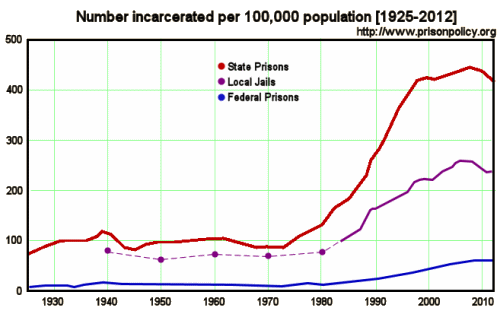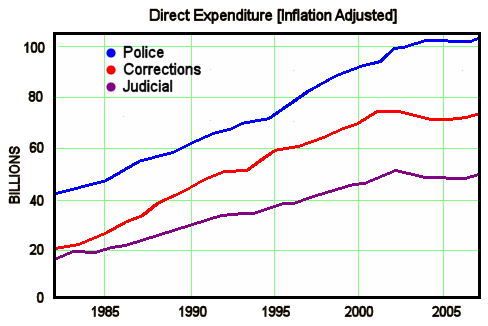I’m back from my tangent now. I wasn’t offering my objections to that legal study [An Institutionalization Effect…] as a proof in transinstitutionalization? III…, but more as an example of a place where having the numbers work out in some mathematical model is one thing, but it doesn’t necessarily prove the relationship in the conclusions. My own guess is that the shoddy implementation of deinstitutionalization, the rise in violent crimes from 1980 through 2000, and our becoming the biggest jailer on the planet are definitely related to each other, but that all three are parameters that relate to something else, something unmeasured that has something vital to say about our country’s as yet unwritten history of the second half of the 20th century. I expect that the way we’ve dealt with chronic mental illness in general belongs in that unwritten story too.
I don’t know anything much about incarceration except that it’s something societies do when they don’t know what else to do. The creation of a dual system [prisons and asylums] had an intent apparent in the very names we use to talk about them, and by the mid twentieth century, that distinction between institutions had lost its meaning. The coming of effective antipsychotic medications at the mid-century mark may have been the key that unlocked the door to the State Hospitals, but it was anything but a cure. Whether you think of psychotic illness as biological or psychological, a disease or a collection of conditions, or something else – the antipsychotics are symptomatic medications [nothing like penicillin that cures certain infections or insulin that replaces something that’s not working right]. They are often dramatically effective for the positive symptoms of acute psychosis but do nothing of note for the less dramatic negative symptoms [anhedonia, cognitive deficits, lack of motivation, etc.] nor for the often elaborate delusions seen in chronic paranoia.
One of he things I liked about the articles by Seth Prins was that he transcended all the rhetoric that often goes with this issue and seemed to be after the facts. What was not in his data that I wanted to see was the distinction between jails and prisons. I couldn’t find anything omnibus on jails for mental illness prevalence, but I did, at least, find some comparative total incarceration rates:

I’ll have to admit that I’m overwhelmed by these numbers. I had no idea that the incarceration rates were this high. I keep running across the phrase, "America’s experiment with mass incarceration," a label that seems apt [apparently it was an easier experiment to do than it has been to undo]. And it has hardly been cheap…

Speculations about the causes for our high rate of incarceration and the over-representation of the mentally ill in the prison and jail populations are met with divisive opinions about what to do about either situation. One pole, for example, supports the solutions proposed by the Treatment Advocacy Center advocatng community commitment including mandated medication. On the other pole, there is strong opposition to those methods from civil libertarians groups [see here-we-go-again?]. While the debates are often cached in terms of biomedicine and psychiatry versus other mental health disciplines and the civil liberties, or neuroscience versus humanism, my impression is that the mental health disciplines as a group [psychiatry, psychology, social work, etc.] have been otherwise preoccupied for the last quarter-century, and with the exception of those directly employed by public facilities or those involved in brain research, they have been monotonously saying the same things they said a long time ago. There is so much in this story to decry, and there’s certainly still a lot of decrying going on, but solutions or progress? not so much.
Commentary: Not Just Variation in Estimates: Deinstitutionalization of the Justice Systemby Jeffrey Draine and Miguel Muñoz-LaboyPsychiatric Services. 2014 65[7]:873-873.… In 2002, the first author and his colleagues questioned the presumption that the large number of incarcerated people with mental illness was attributable to failures in the assessment and treatment of mental illness and concluded that there is no reliable evidence that directing resources toward psychiatric treatment would have a significant impact on incarceration rates. In this commentary, we argue that this conclusion remains true. In the article by Prins, the implied logic is that there is interpretive value in examining variations in the rates of mental illnesses in jails and prisons to discern the impact of psychiatric interventions. Holding to the principle that the most parsimonious explanation is best, the factor that explains the variation in the proportions of prisoners with mental illness is variation in correctional policy and practice among jurisdictions and over time, rather than variation in access to treatment for mental illness or in how mental illness is assessed or counted in prisons and jails. The more recent variation in rates of mental illness is also likely enhanced by the beginning of a shift in correctional policy: the decline of incarceration in prisons.
Abramson laid the groundwork for examining connections between deinstitutionalization of psychiatric treatment and the rising number of incarcerated people with mental illnesses. Historically, institutions such as orphanages, poorhouses, and asylums have, each in their own time, experienced a profound increase in their populations, which was followed by a period of deinstitutionalization. Initially, the reasons given for deinstitutionalization are humane treatment, but eventually the most persuasive arguments center on cost and efficiency in state systems and the availability of plausible alternatives. In the United States, practice shifted from poorhouses to outdoor relief, charity movements, and social work; from orphanages to child welfare systems, foster care, and juvenile justice systems; from asylums to community mental health; and now from prisons to community corrections.
With the emergence of community corrections and the eventual downsizing of prisons and jails, many people with mental illness once incarcerated in conventional facilities will more often be involved in various forms of community corrections… Correctional health care policy focused on large prisons and jails has not caught up with the impact of deinstitutionalization in the provision of psychiatric care to vulnerable populations. As a result, a growing number of individuals with serious psychiatric disorders are left without reliable access to effective psychiatric treatment. This commentary seeks to refocus attention away from efforts to establish a standard for rates of incarcerated persons with mental illness in conventional facilities with the aim of informing mental health interventions. The action is not there. The place for action in innovation, change, and planning is in community settings. Our goal should be to document variations across place and time in how the differences and changes in corrections practices interrupt effective care and to develop creative ways to recognize as a reality in the justice system the ongoing changes in corrections environments and the broad variation in incarcerated populations.
There is always a lag in the numbers and from the business world we are hearing the beginnings of a slow down in the jail and prison business. This would be the first indicator that the justice system is trying to eliminate the large number of people incarcerated for minor offenses.
A personal frustration is that with any government program we immediately see an attempt to game the system by those who would financially gain. Staff is seen as a cost and there is a justification to maximize this cost with every increasing patient loads.
Unions see public sector jobs as their last great hope and are willing to build cost at the expense of the program. Try to remove a problem employee; it is not going to happen, even with a criminal conviction.
We also need to discuss income bias. Today we see people classified by their perceived economic status. My wife and I have suffered this insult as we are normal people and have been pushed to the back of the line, or treated in a less than civil manner, because we do not dress in a certain manner or speak with a certain vocabulary on an everyday basis.
Those with fewer resources do find themselves at a disadvantage in their everyday dealings. Credit is not given to their opinions or feelings, and any explanation they have is discounted.
Showing up at the doctor’s office in jeans and a polo shirt I receive a very different response than when I arrive in dress slacks and a dress shirt. Telling the doctor I am retired they will ask about my disability, explaining we saved and were very fortunate often brings a negative response since they feel they should be able to retire as they are more valuable than just a businessman.
This is a complicated problem, and yes we have made a mess of it.
Steve Lucas
Steve– I don’t know how many of these jobs are unionized. A lot of government work is performed by contractors these days.
In keeping with the theme of this blog, examining scientific studies, extrapolating meaning from data, trying to make sense of the conclusions drawn by psychiatrists, I can’t avoid calling attention to psychiatry, the subspecialty of medicine that has totally corrupted the scientific process and make a mockery of the medical model. Yet, for some unexplained reason, psychiatry continues to exert its authority by analyzing social and cultural problems, that rational folks credit psychiatry for creating– the worst being the ever expanding, definition of *mental illness*.
Thank goodness for humanistic community building, peer support respites and the growing awareness that unity around the premise of saving each other from psychiatry is creating the bonds of trust and friendship we all need for mental, emotional and spiritual health.
I recommend Michelle Alexander’s The New Jim Crow: Mass Incarceration in the Age of Colorblindness, which I think could point us in a very helpful direction in understanding these phenomena. In that book, Alexander convincingly demonstrates that Mass Incarceration is a racist project. From there, it seems almost certain that the numbers of “mentally ill” in jails and prisons is disproportionately black and brown compared to the numbers in psychiatric hospitals.
There should be a continuing and vigorous dissection of why black and brown people in our country are more likely to have their primary label be “criminal” rather than “mentally ill” when compared with white folks.
If there is any racial demographic data in these papers. I would be curious to read your report on that as well.